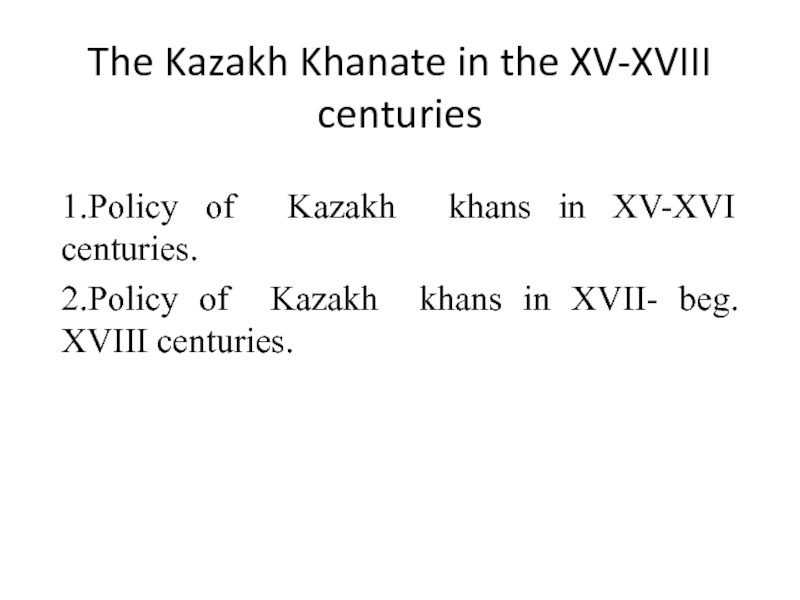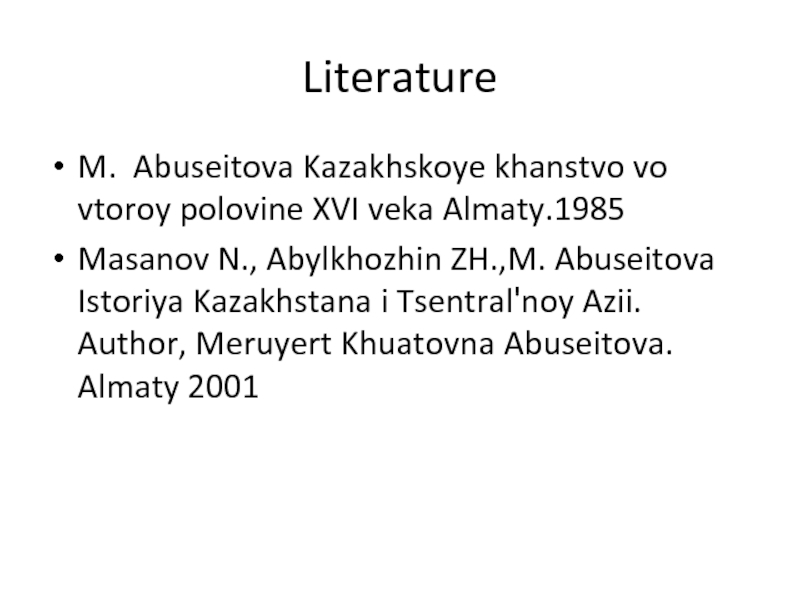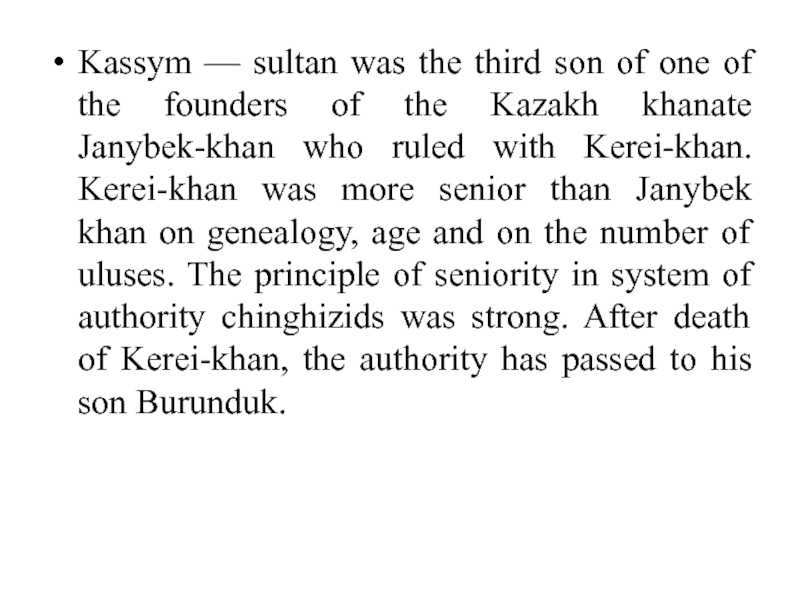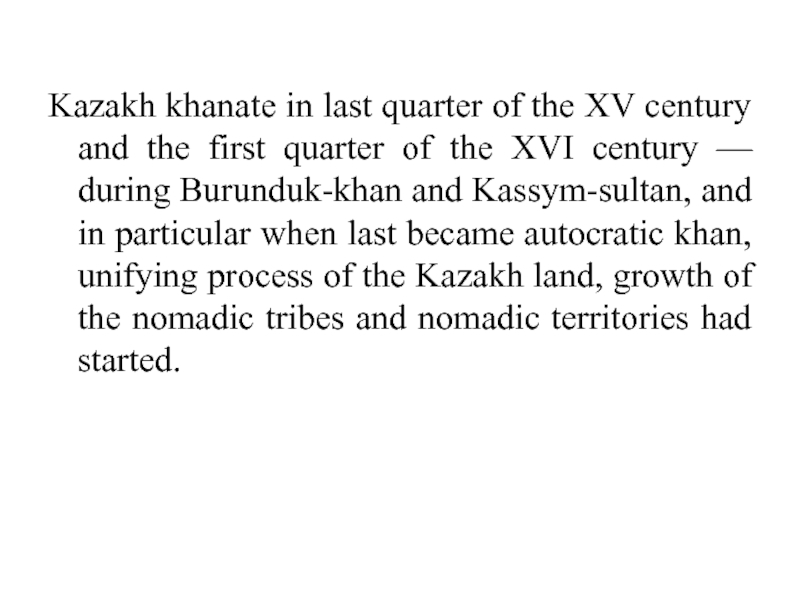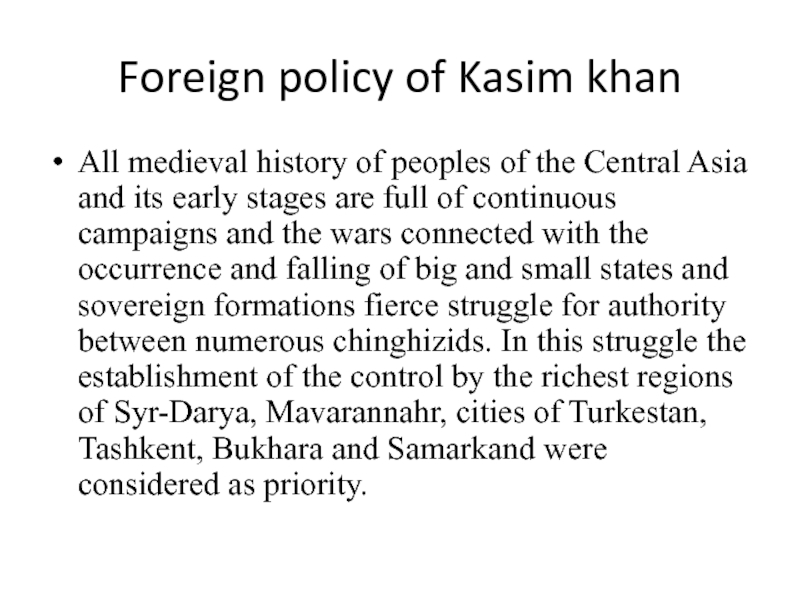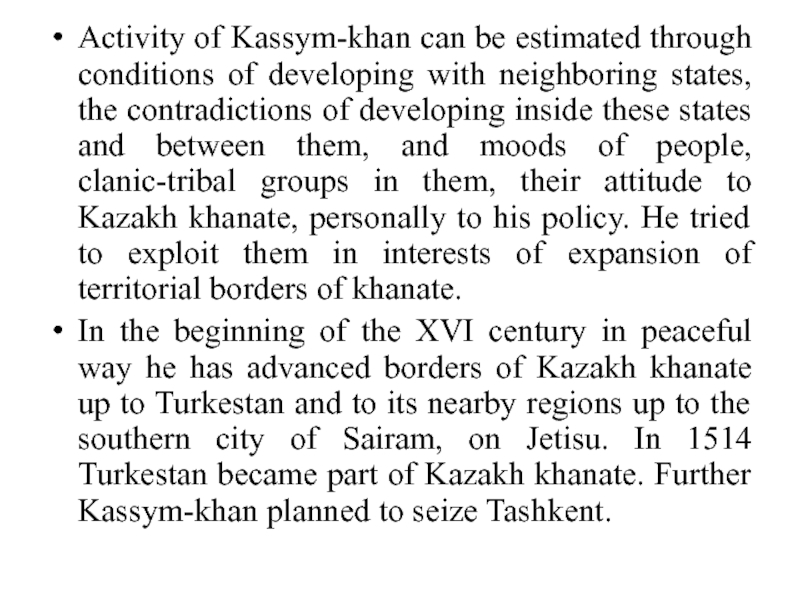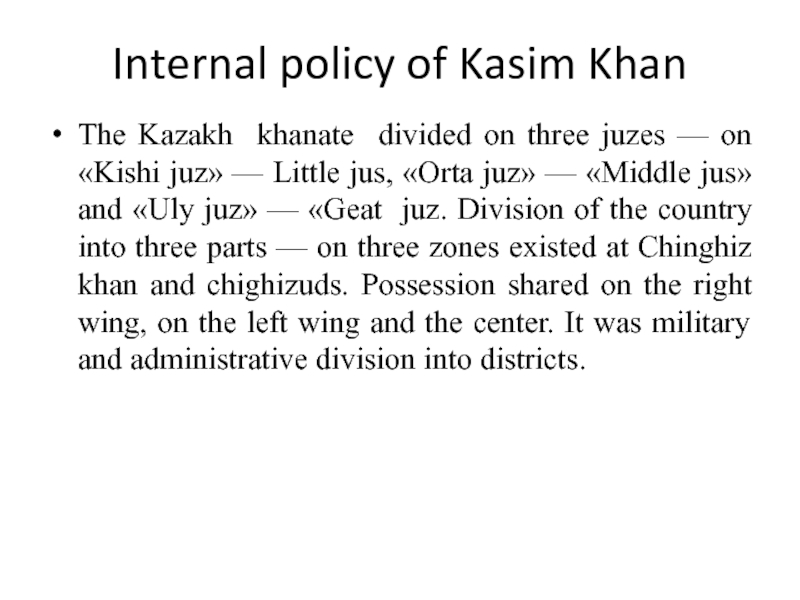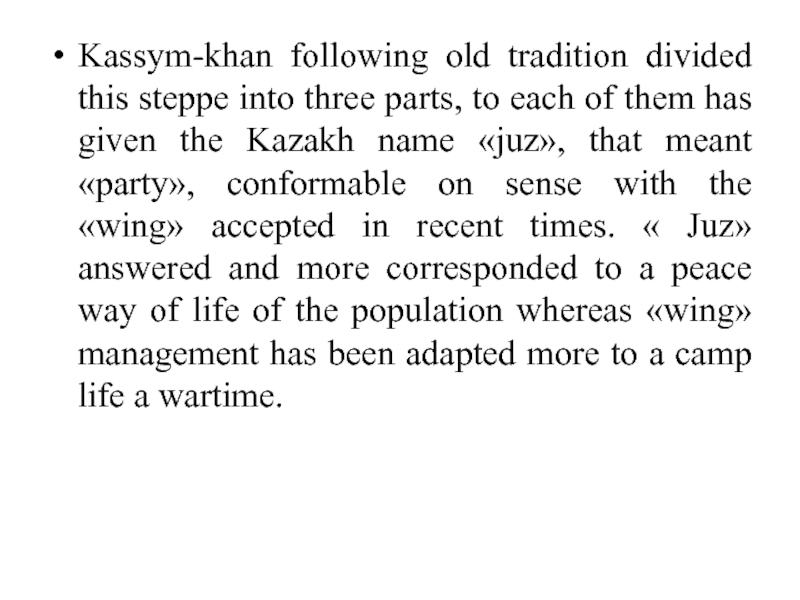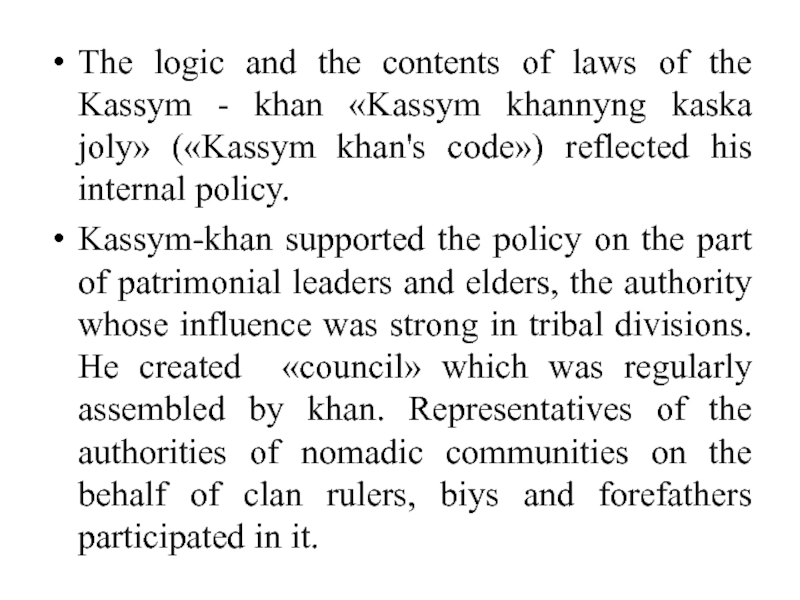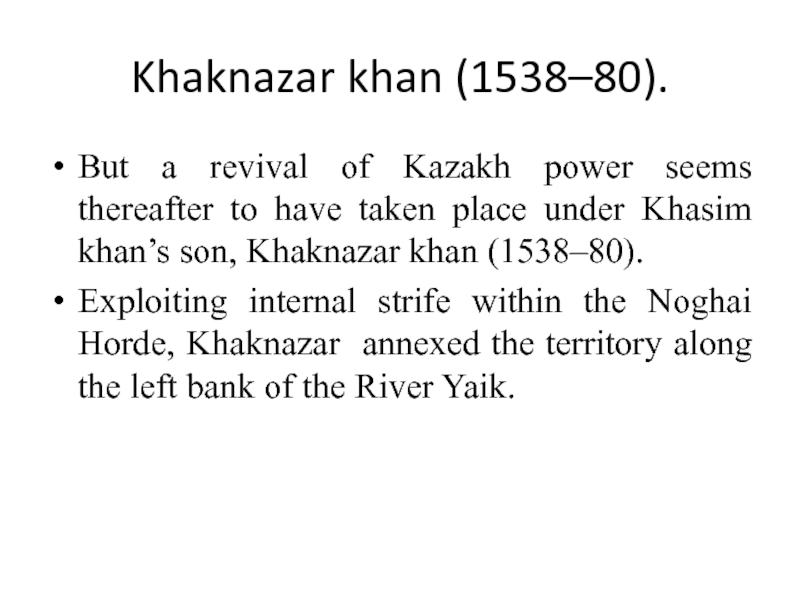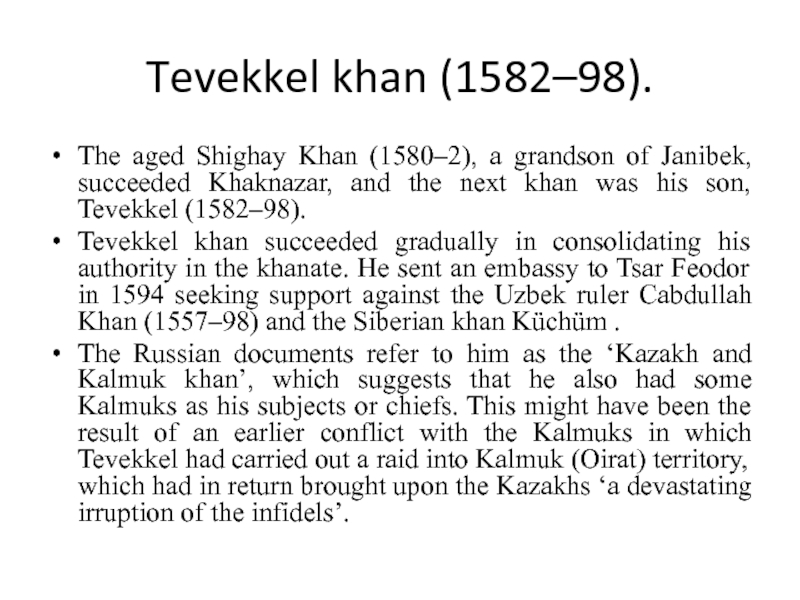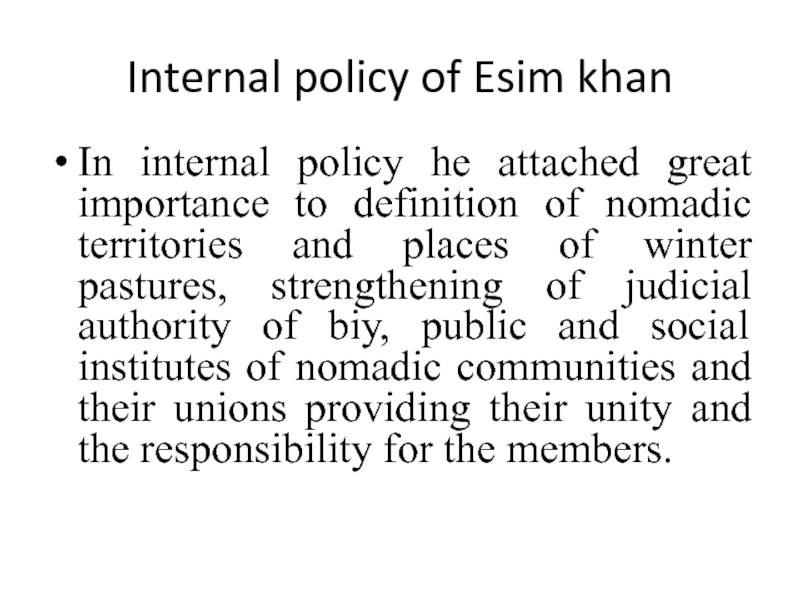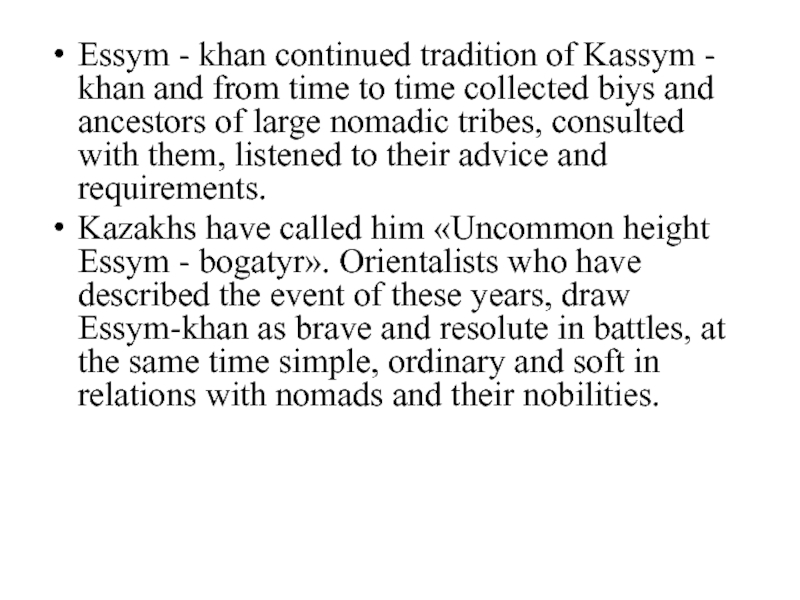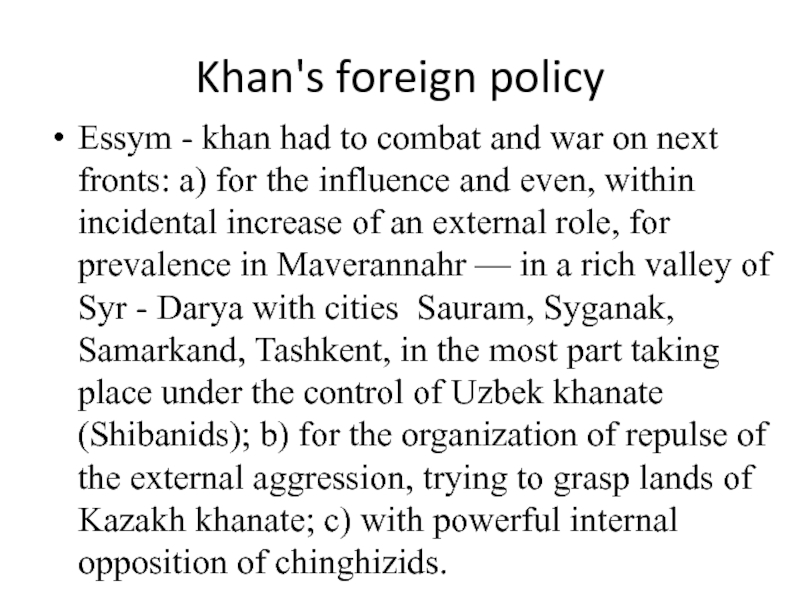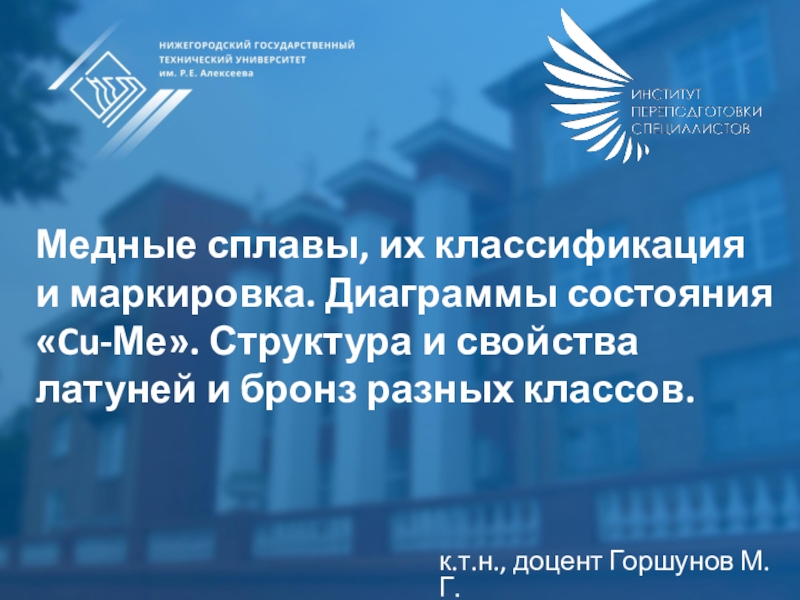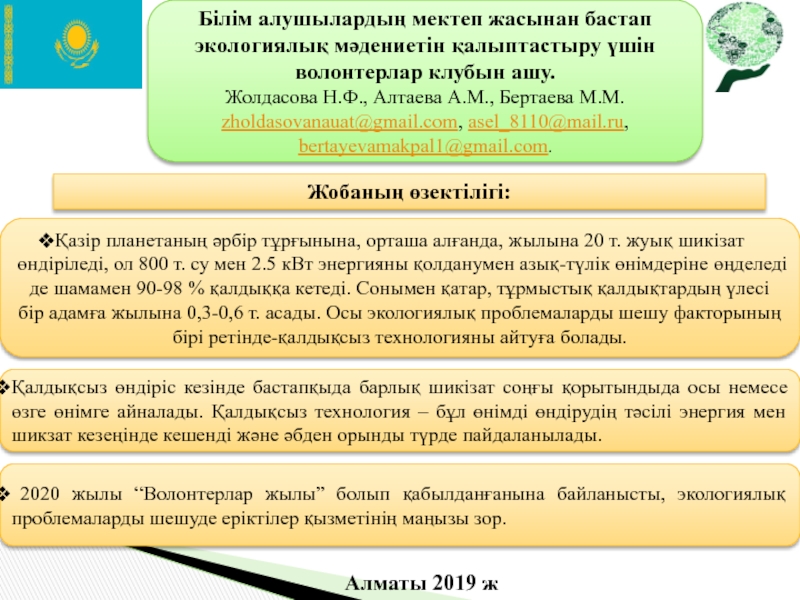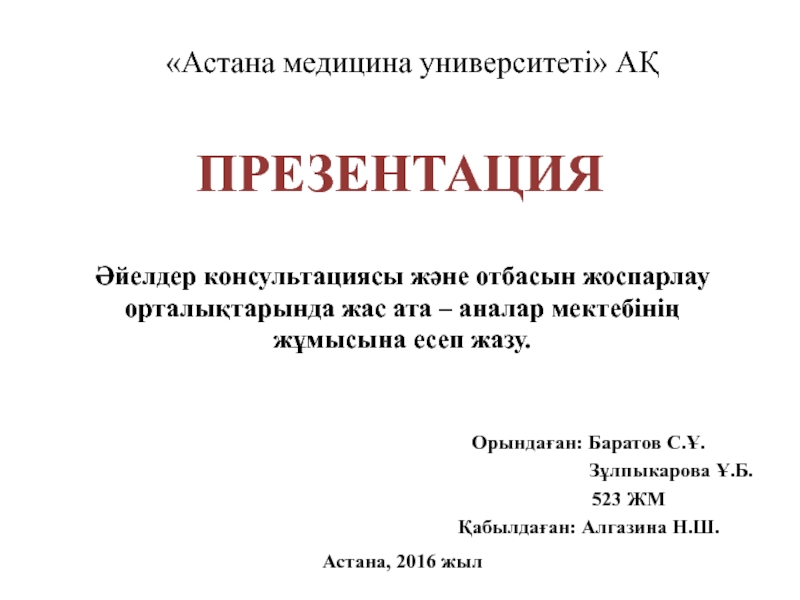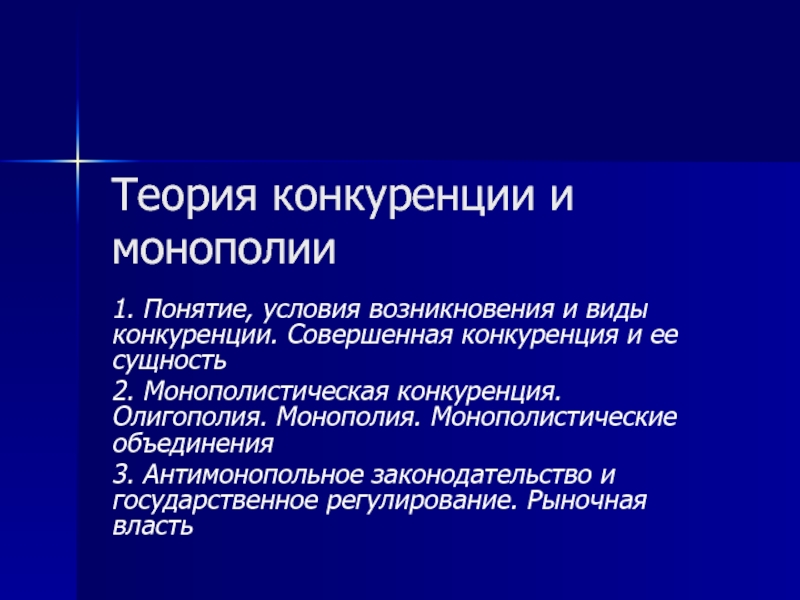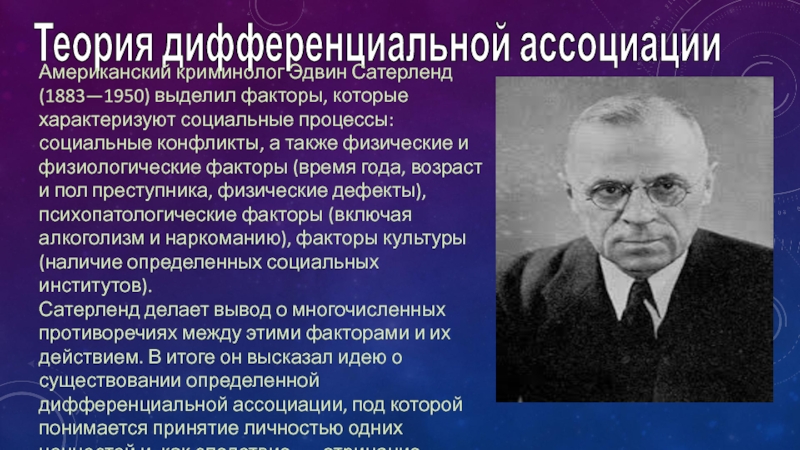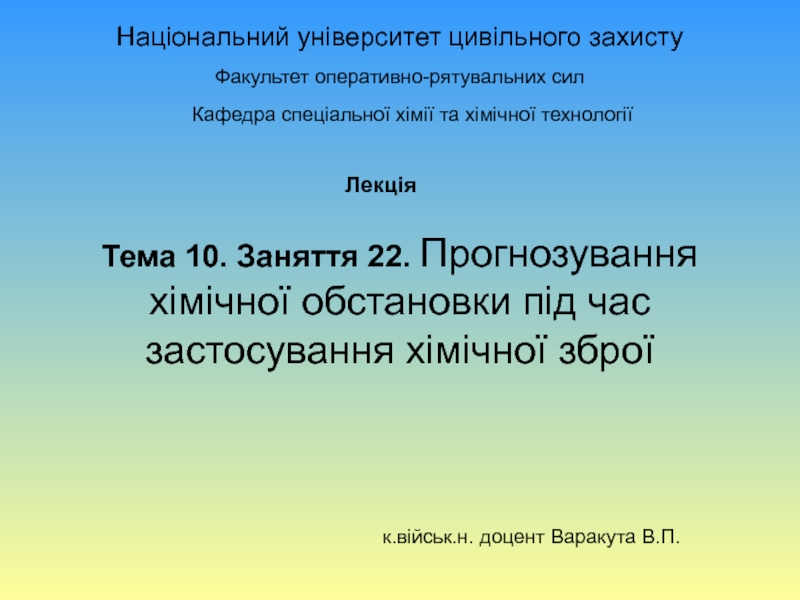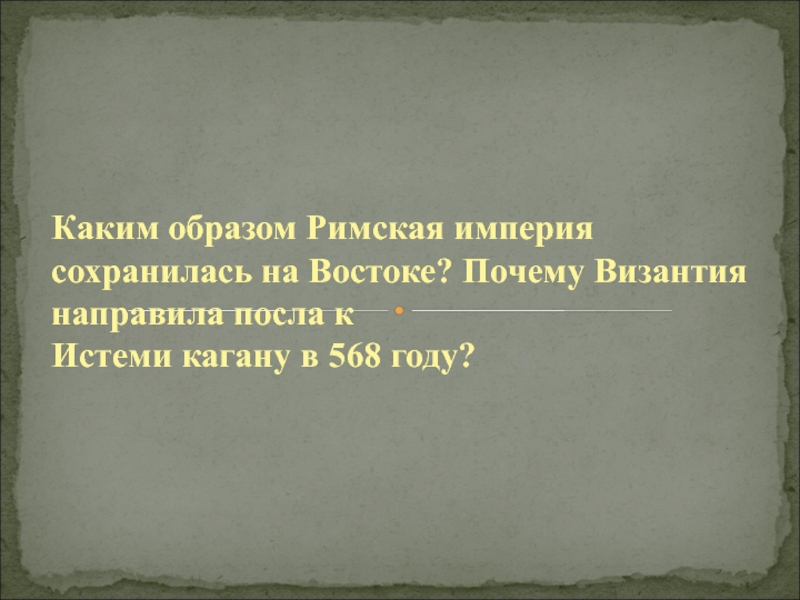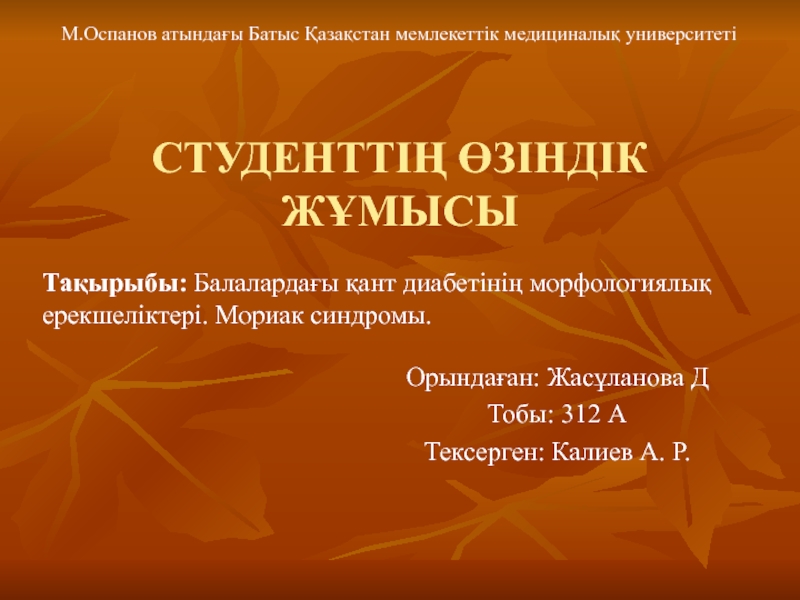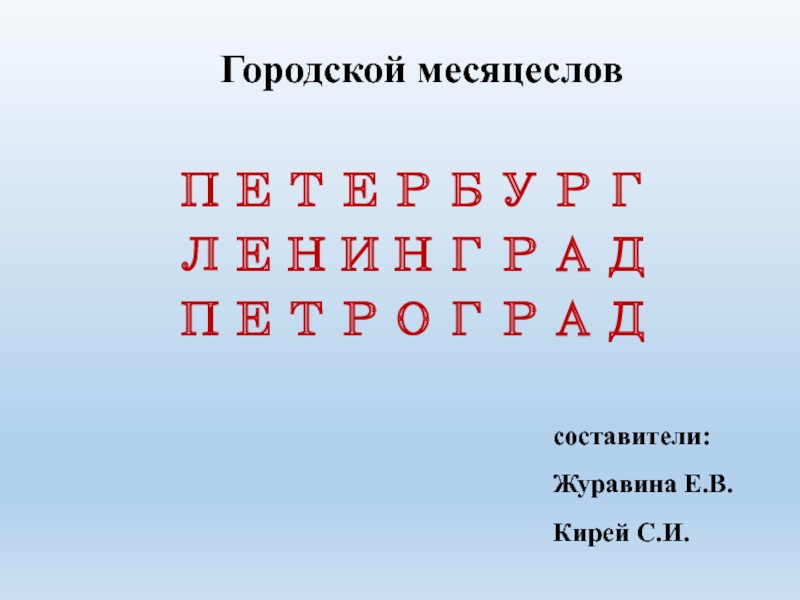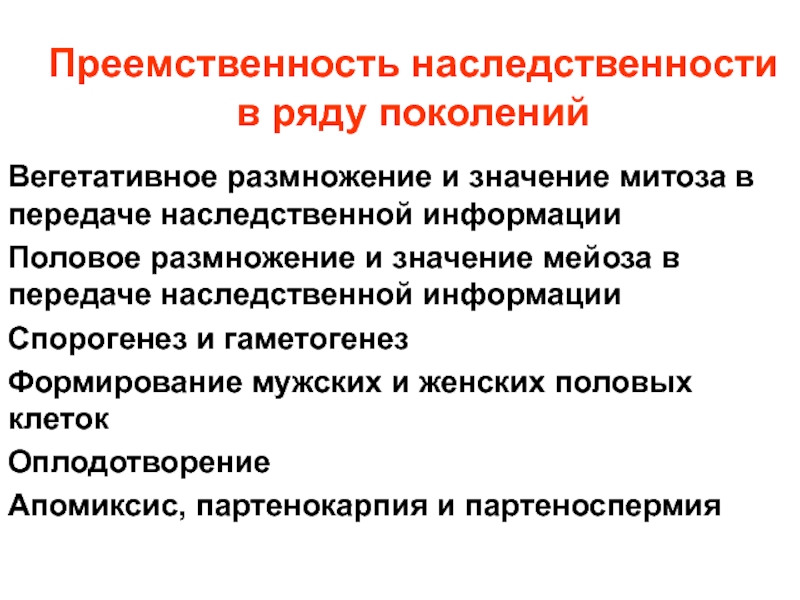Разделы презентаций
- Разное
- Английский язык
- Астрономия
- Алгебра
- Биология
- География
- Геометрия
- Детские презентации
- Информатика
- История
- Литература
- Математика
- Медицина
- Менеджмент
- Музыка
- МХК
- Немецкий язык
- ОБЖ
- Обществознание
- Окружающий мир
- Педагогика
- Русский язык
- Технология
- Физика
- Философия
- Химия
- Шаблоны, картинки для презентаций
- Экология
- Экономика
- Юриспруденция
The Kazakh Khanate in the XV-XVIII centuries
Содержание
- 1. The Kazakh Khanate in the XV-XVIII centuries
- 2. Literature M. Abuseitova Kazakhskoye khanstvo vo vtoroy
- 3. VocabularyEulogize- превозносить, восхвалятьReconcile – мирить, примирять, согласоватьConcurrence – стечение обстоятельствInfringement – нарушение, несоблюдение
- 4. Policy of Kassym - khanKassym - khan
- 5. He was Khan ten years
- 6. Kassym — sultan was the third son
- 7. Kazakh khanate in last quarter of the
- 8. Foreign policy of Kasim khanAll medieval history
- 9. Activity of Kassym-khan can be estimated through
- 10. Kazakh khanate bordered in the west with
- 11. Internal policy of Kasim KhanThe Kazakh khanate
- 12. Kassym-khan following old tradition divided this steppe
- 13. The logic and the contents of laws
- 14. Takhir khan (1523–33)after the death of Khasim
- 15. Khaknazar khan (1538–80).But a revival of Kazakh
- 16. Tevekkel khan (1582–98).The aged Shighay Khan (1580–2),
- 17. Just before Abdullah Khan’s death in 1598,
- 18. Esym - khan (1598 — 1628)Essym -
- 19. Essym-khanEssym - khan has used desperate attempt
- 20. Essym-khan wanted to be similar to Kassym
- 21. Internal policy of Esim khanIn internal policy
- 22. Essym - khan continued tradition of Kassym
- 23. Khan's foreign policyEssym - khan had to
- 24. In spite of the fact Essym -
- 25. In new war between them Essym -
- 26. When the throne passed in 1680 to
- 27. Скачать презентанцию
Literature M. Abuseitova Kazakhskoye khanstvo vo vtoroy polovine XVI veka Almaty.1985Masanov N., Abylkhozhin ZH.,M. Abuseitova Istoriya Kazakhstana i Tsentralʹnoy Azii. Author, Meruyert Khuatovna Abuseitova. Almaty 2001
Слайды и текст этой презентации
Слайд 1The Kazakh Khanate in the XV-XVIII centuries
1.Policy of Kazakh khans
in XV-XVI centuries.
centuries.Слайд 2Literature
M. Abuseitova Kazakhskoye khanstvo vo vtoroy polovine XVI veka
Almaty.1985
Masanov N., Abylkhozhin ZH.,M. Abuseitova Istoriya Kazakhstana i Tsentralʹnoy Azii.
Author, Meruyert Khuatovna Abuseitova. Almaty 2001Слайд 3Vocabulary
Eulogize- превозносить, восхвалять
Reconcile – мирить, примирять, согласовать
Concurrence – стечение обстоятельств
Infringement
– нарушение, несоблюдение
Слайд 4Policy of Kassym - khan
Kassym - khan takes an outstanding
place in the history of Kazakhstan. Kassym entered khan throne
in 1510 i.e. and inherited shattered full of different tribes, which hadn’t developed uniform government.Слайд 5 He was Khan ten years (1510 — 1521),
but he began to rule much earlier before geting khan
title. He was second khan, alongside with Burunduk khan, i.e. in result more than his 50 - years state activity, including in a role of the sultan — headed the most part of the khanate.Слайд 6Kassym — sultan was the third son of one of
the founders of the Kazakh khanate Janybek-khan who ruled with
Kerei-khan. Kerei-khan was more senior than Janybek khan on genealogy, age and on the number of uluses. The principle of seniority in system of authority chinghizids was strong. After death of Kerei-khan, the authority has passed to his son Burunduk.Слайд 7
Kazakh khanate in last quarter of the XV century and
the first quarter of the XVI century — during Burunduk-khan
and Kassym-sultan, and in particular when last became autocratic khan, unifying process of the Kazakh land, growth of the nomadic tribes and nomadic territories had started.Слайд 8Foreign policy of Kasim khan
All medieval history of peoples of
the Central Asia and its early stages are full of
continuous campaigns and the wars connected with the occurrence and falling of big and small states and sovereign formations fierce struggle for authority between numerous chinghizids. In this struggle the establishment of the control by the richest regions of Syr-Darya, Mavarannahr, cities of Turkestan, Tashkent, Bukhara and Samarkand were considered as priority.Слайд 9Activity of Kassym-khan can be estimated through conditions of developing
with neighboring states, the contradictions of developing inside these states
and between them, and moods of people, clanic-tribal groups in them, their attitude to Kazakh khanate, personally to his policy. He tried to exploit them in interests of expansion of territorial borders of khanate.In the beginning of the XVI century in peaceful way he has advanced borders of Kazakh khanate up to Turkestan and to its nearby regions up to the southern city of Sairam, on Jetisu. In 1514 Turkestan became part of Kazakh khanate. Further Kassym-khan planned to seize Tashkent.
Слайд 10Kazakh khanate bordered in the west with Nogai horde, established
the control over the city Saraishyk in Jaiyk (Ural), which
was the political and economic center of Nogai hordes. Kassym-khan develpoped peaceful relations with Nogai horde.Слайд 11Internal policy of Kasim Khan
The Kazakh khanate divided on three
juzes — on «Kishi juz» — Little jus, «Orta juz»
— «Middle jus» and «Uly juz» — «Geat juz. Division of the country into three parts — on three zones existed at Chinghiz khan and chighizuds. Possession shared on the right wing, on the left wing and the center. It was military and administrative division into districts.Слайд 12Kassym-khan following old tradition divided this steppe into three parts,
to each of them has given the Kazakh name «juz»,
that meant «party», conformable on sense with the «wing» accepted in recent times. « Juz» answered and more corresponded to a peace way of life of the population whereas «wing» management has been adapted more to a camp life a wartime.Слайд 13The logic and the contents of laws of the Kassym
- khan «Kassym khannyng kaska joly» («Kassym khan's code») reflected
his internal policy.Kassym-khan supported the policy on the part of patrimonial leaders and elders, the authority whose influence was strong in tribal divisions. He created «council» which was regularly assembled by khan. Representatives of the authorities of nomadic communities on the behalf of clan rulers, biys and forefathers participated in it.
Слайд 14Takhir khan (1523–33)
after the death of Khasim Khan in 1518
the Kazakh khanate wasn’t stable centralized state because struggle for
power began among the khans and sultans. Mamash (Muhammad Husayn), the son and heir of Khasim, was killed, and Takhir became khan (1523–33). But he couldn’t keeping Kazakh tribes together. His horde of 400,000 people suddenly deserted him. He had to seek the assistance of the Kyrgyz of Moghulistan, among whom he died.Слайд 15Khaknazar khan (1538–80).
But a revival of Kazakh power seems thereafter
to have taken place under Khasim khan’s son, Khaknazar khan
(1538–80).Exploiting internal strife within the Noghai Horde, Khaknazar annexed the territory along the left bank of the River Yaik.
Слайд 16Tevekkel khan (1582–98).
The aged Shighay Khan (1580–2), a grandson of
Janibek, succeeded Khaknazar, and the next khan was his son,
Tevekkel (1582–98).Tevekkel khan succeeded gradually in consolidating his authority in the khanate. He sent an embassy to Tsar Feodor in 1594 seeking support against the Uzbek ruler Cabdullah Khan (1557–98) and the Siberian khan Küchüm .
The Russian documents refer to him as the ‘Kazakh and Kalmuk khan’, which suggests that he also had some Kalmuks as his subjects or chiefs. This might have been the result of an earlier conflict with the Kalmuks in which Tevekkel had carried out a raid into Kalmuk (Oirat) territory, which had in return brought upon the Kazakhs ‘a devastating irruption of the infidels’.
Слайд 17Just before Abdullah Khan’s death in 1598, Tevvekel launched an
invasion of the Maveranahr and defeated at a place between
Tashkent and Samarkand. In 1598, after Abdullah Khan’s death, Tevvekkel seized ‘Aksi, Andijan, Tashkent and Samarkand’. His army numberd 70–80,000 people. Tevvekel’s conquests were soon retaken by the Uzbeks, but Tashkent and Turkestan remained with the Kazakhs until 1723.Слайд 18Esym - khan (1598 — 1628)
Essym - sultan who was
born at the end of 50th at the beginning of
60th years of the XVI century was the son of Shigai - khan.Essym - khan has ascended on khan throne in heavy struggle against contenders, and in conditions of weakening and disintegration of once powerful state. During this time khan in Kazakh khanate carrying out an aggressive policy in relation to (Zhungar state .Russian state, etc.).
Essym-khan showed his talent as the organizer, the reformer of low and as the commander.
Слайд 19Essym-khan
Essym - khan has used desperate attempt in preservation of
integrity of the Kazakh state. The most successful was his
activity in the field of the device and self - determination of nomadic tribes, in preservation behind them and the traditional orders of departure of management and authorities of that time which was sanctioned and partly reformed by Kassym - khan.Essym-khan developed Kasim khan’s low and was named «Essym khannyng eski joli» can be translated as «The codes of Essym - khan». It was the collection of the basic legal establishments and political activity of Essym - khan.
Слайд 20Essym-khan wanted to be similar to Kassym - khan and
to follow his policy in strenthening of nomadic culture in
Kazakh state. Affairs, orders and innovations of Essym-khan in these directions have found support and approval from masses of nomads. They were transferred from one generation in another and fixed as provisional public model under the name «Essym khannyng eski joly» — «The code of Essym - khan».Слайд 21Internal policy of Esim khan
In internal policy he attached great
importance to definition of nomadic territories and places of winter
pastures, strengthening of judicial authority of biy, public and social institutes of nomadic communities and their unions providing their unity and the responsibility for the members.Слайд 22Essym - khan continued tradition of Kassym - khan and
from time to time collected biys and ancestors of large
nomadic tribes, consulted with them, listened to their advice and requirements.Kazakhs have called him «Uncommon height Essym - bogatyr». Orientalists who have described the event of these years, draw Essym-khan as brave and resolute in battles, at the same time simple, ordinary and soft in relations with nomads and their nobilities.
